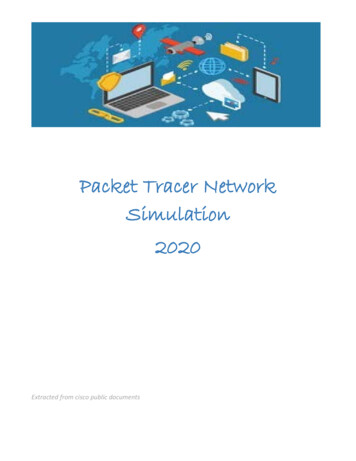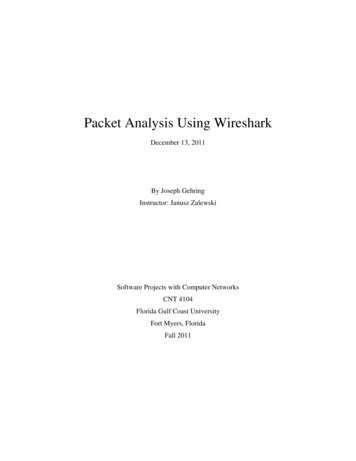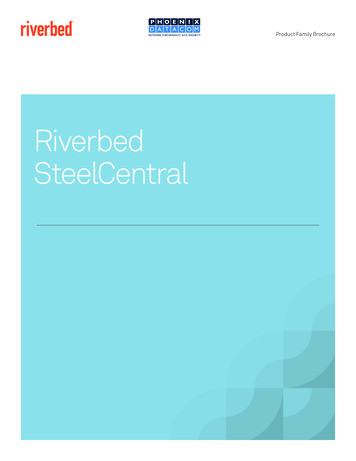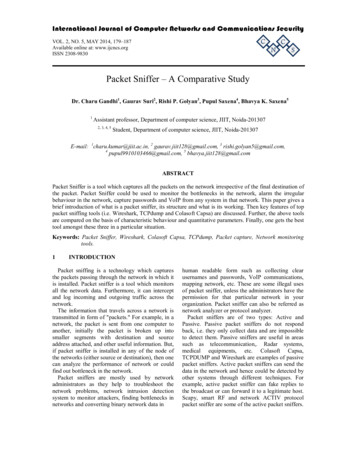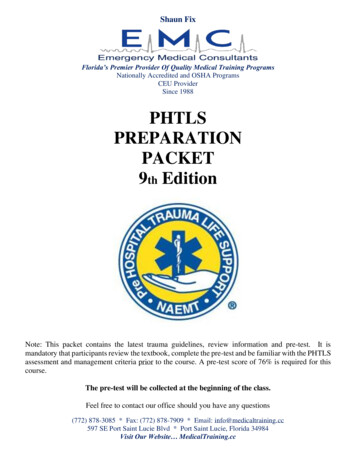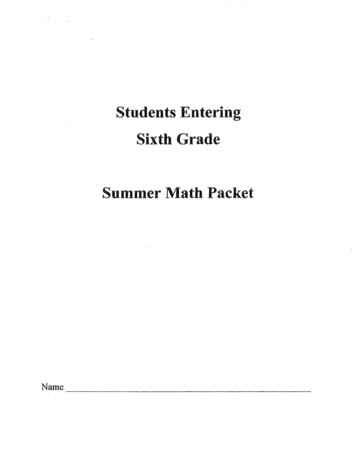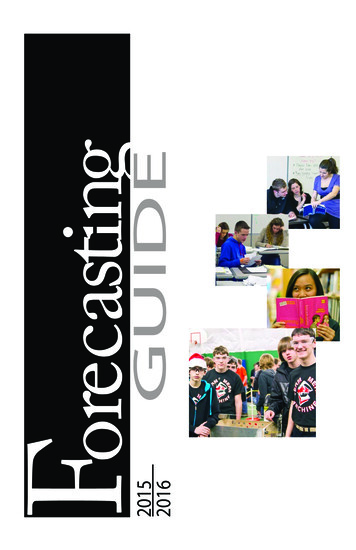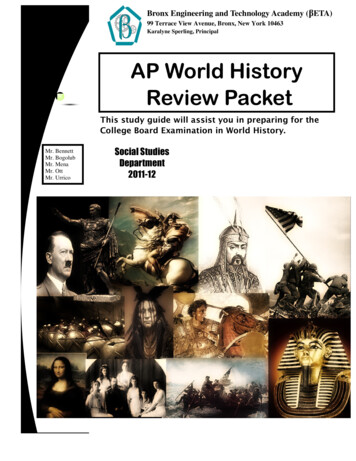
Transcription
Bronx Engineering and Technology Academy (βETA)99 Terrace View Avenue, Bronx, New York 10463Karalyne Sperling, PrincipalAP World HistoryReview PacketThis study guide will assist you in preparing for theCollege Board Examination in World History.Mr. BennettMr. BogolubMr. MenaMr. OttMr. UrricoSocial StudiesDepartment2011-12
Specific Terms, People, Ideas, and EventsAP WORLD HISTORY rapanCivilizationShang DynastySocial StructureLoss of EmpireCaste eaucracyBureaucracyAristotleIndian OceanTradeEXPLAINATION / SIGNIFICANCEPopulation settlements; who lives where, why; birth-rates – increase or decrease; urban orruralHunters and gatherersSocieties that have advanced culture including a political system, job specialization, writtenlanguage, and complex religionsThe idea that two or more different cultures could have invented the same thing withoutbeing influenced by another. Example: the wheel was invented in different places atdifferent timesMelting of metals for human use; examples: copper for decorations, iron for tools andweapons, etc. Civilizations that mastered metallurgy advanced quicker than others.The belief in more than one god. Dominate belief system prior to Judaism.Another name for the Indus River Valley civilization; known for advanced cities ofMohenjo-DaroDeveloped along the Yellow River (Huang He); known for oracle bonesAll civilizations have some type of social structure. Most early societies had a socialstructure that included rulers and priests at the top of the social structure and peasants andslaves at the bottom.There are major upheavals when an empire collapses. The Han, Roman, and GuptaEmpires all collapsed during the Foundations era. The collapse of the Roman Empire wasmore significant because of centralization that had been placed on all aspects of society tothe institutions in Rome. Europeans were lost and shocked after the fall of the RomanEmpire. In China, their concept of Dynastic Cycle led to acceptance of the fall as a naturaloccurrence.Aryan/Hindu system of social divisions based upon birth. People could not move casteexcept through reincarnation. Associated with racism. Comparable to Confucian conceptof order. Most social systems are pretty class-restrictive – most people stay in the classhe/she was born into.Refers to civilizations that were considered far more advanced than others. Theseincluded: Han, Gupta, Greek, and Roman. They all had major advanced in technology, art,trade, and political systems.Movement from foragers to permanent settlers. Led to villages and communities. Also ledto gender restrictions.Male dominated societies. All major civilizations have been patriarchal.An elaborate government system that has numerous people involved in processing andadministering the government. Most known in China and is associated with the ScholarGentry class created through the Civil Service Exams.Greek philosopher who is also known for scientific observations. Most of his conclusionswere not challenged until the Scientific Revolution.Provided trading opportunities between Africa and Asia. Europe was included somewhat.
BantusCaliphatePolynesiansDar st ismByzantine EmpireWorld TradeNetworkColumbianExchangeMamluksNomadic peoples from Africa who traveled around Africa spreading language and farmingmethodsArab/Islamic religious and political leader. The first caliph after Muhammad was AbuBakr.Peoples of southwest Pacific Ocean who traveled from island to island via boats; includesnatives of New Zealand, Samoa, and HawaiiUnity in the Islamic world through language and religion. Similar to ”nationalism” buttranscends boundaries of race and ethnic background.A person who intentionally spreads a faith. Historically, Buddhists, Christians, andMuslims have been active in missionary outreach.Refers to major advances and changes occurring in an economic system. Historically wouldapply to the major changes in Tang and Song China.The split in Christianity in 1054. Prior to this time there was only one “Christian Church.”The Catholic (universal) Church split into a Roman/Western Church and an EasternOrthodox Church. Issues that led to the schism included the use of icons, the role of thePope, and the celibacy of priests. They remain slip today. Roman Catholics are dominantin Western Europe, Canada, Australia, and Latin America. Eastern Orthodoxy is dominantin Greece, Russia, eastern Europe, and the Middle East (those who are Christians in the MEare predominantly Orthodox. During one of the Crusades the Europeans actually sackedConstantinople, the center of Orthodox Christianity. Pope John Paul II apologized in the1990s.Movements of large groups of people from one place to another. Normally very disruptiveto the area being “invaded.” Warfare, political upheaval, and conflict normally occur, asdoes cultural diffusion. Most notable migrations: Huns, Germans, Arabs, Vikings, Bantu,Mongols, Turks, and Aztecs.Black Death that devastated Europe during the Middle Ages. Came from Asia along traderoutes and were spread by the fleas on rats. Was called a pandemic due to its quick nature.The settlement of people into cities. Normally associated with industrialization, as thatwould cause large numbers of people to settle near each other. China was the mosturbanized during the Middle Ages, while European cities became the most urbanized afterthe Renaissance.Political system used in Europe and Japan. The system was based on military service(knights and samurais) in exchange for land grants made to the lords or shoguns. In Europethe King had a lot of power while in Japan, the Emperor was only a figurehead. The Codeof Chivalry guided the behavior of the European knights while the Code of Bushido guidedthe behavior of the Japanese Samurai.The Eastern Roman Empire that outlasted the Roman Empire by hundreds of years. It’slocation and control of the Dardanelles provided riches to the empire. It served as thecenter of Christianity for the eastern part of Europe. It encompassed large sections of Asiaand parts of Europe and Africa. Nationalism caused problems in the empire as Arabssought to separate themselves from the Byzantine Empire and support Islam and conquest.During the period prior to Columbus the major trading networks were the Indian OceanTrade, the Silk Roads, and the Trans-Saharan trade routes. These allowed for a tradingnetwork that included Asia, Africa, and Europe. A truly “world” trade network would notdevelop under the discovery of the Americas.Exchange of food, animals, and diseases from the Americas to Europe and Asia; led to thedeath of millions of Native Americans; led to the survival of millions of Europeans (potato)Christian slaves who were used as soldiers in the Abbasid and other Islamic dynasties.
ManorialismCrusadesPapacyEmpiresSlave ucianismConfucianismArtisticMovements1450 – 1750ImperialismCoercive LaborSystemsEmpire BuildingSince the Koran forbids Muslims from fighting each other, Mamluks were useful. Manyconverted to Islam, but their lack of allegiance to tribes helped the caliphates conquerareas. On several occasions they actually rose to power and ruled. Mamluks took overEgypt and ruled from 1250 – 1380 and defeated the Ottomans. Mamluks also served inNapoleon’s army and briefly overthrew Ottoman rule in Baghdad.The economic system of the Middle Ages that was centered on the manor (like aplantation). Manors were self-sufficient and were awarded to lords by the Kings in thefeudal contract.Begun in 1095 as an effort by European Christians to take the Holy Land (Jerusalem) fromthe Muslims. The 1st Crusade was somewhat successful in that Jerusalem was secured;however, other crusades were all failures. This era did bring about trade between the“Crusading” states (European countries like France, Spain, and England) and the IslamicStates. Desire for Asian goods increases and Europeans begin to focus on finding waterroutes to Asia.The Pope and the leadership of the Roman Catholic Church. Historically the papacy hasplayed a large role in political affairs in Europe and Latin America. After the fall of theRoman Empire, the Papacy and the Roman Catholic Church provided stability to Europeduring the Middle Ages.Major empires during the 1450 – 1750 period controlled large segments of territory. Theterm “gunpowder empires” applies to most because of their ability to use force to seize largesegments of land. Empires included: China, Ottoman, Portugal, Spain, Russia, France,England, Mughal, Kongo, Benin, Oyo, and Songhay.Slavery has existed since the earliest known history. During the 1450 – 1750 time periodmost slaves were from Africa. Fellow Africans sold many into slavery. Female slaves madeup the bulk of the slaves sent from Africa to the Islamic states. They were usuallyconcubines. The Atlantic Slave Trade sent millions of Africans across the Atlantic to serveas slaves in agriculture.The era of European history when great scientific advances were made. These includeCopernicus and Galileo’s astronomy, Newton’s gravity, physics, and calculus, andexplorations into different types of power. These discoveries helped to start the IndustrialRevolution. They also proved to be challenging for the population and rulers as many ideaschallenged traditional Biblical and governmental teachings.The period dominated by French thinkers. Basic challenges to the authority of the king,freedom of speech, press, and religion, and the role of commoners in the government wererevolutionary. These ideas led to the American, French, and Latin American Revolutions.A mixture of Confucianism and Buddhism.The Renaissance dominated Europe with its glorification of human achievements. TheMughal (Indian) art of the period was inspired by Islamic design and the Taj Mahal is anexample. The Ming Dynasty was building the Forbidden City and mastering porcelainproduction. The Tokugawa Shogunate had Kabuki theatre and Haiku poetry. Russianarchitecture mirrored that found in the Byzantine Empire. In Africa, the Benin civilizationwas using bronze in sculpture.The first wave of imperialism refers primarily to European colonization of the Americas,Africa, and Asia. One country takes over another for economic reasons.Included slavery, indentured servitude, serfdom, and indentured servitude.Process of creating empires. In Africa, it was a system of successor states with new states
opleSiege of izationTheoryRole of Womensimply building upon previous states. In Europe, nations emerged under powerfulmonarchs who sought out new territory to improve economic conditions. In Asia, Chinaconquered most areas directly. Some areas allowed being “tribute states” where regions paymoney not to be conquered.China controlled the exploration (Zheng He) until the Portuguese begin to explore insearch of water routes to Asia. Important explorers included da Gama, Columbus, andMagellan.European monarchs concept that the monarch, normally king, is absolute in power anddoes not have to seek approval, advice, or input from anyone or anything else. Oftenassociated with the Divine Right of Kings concept that the king is only answerable to God.Louis XIV was an example of an absolutist monarch.Led by Martin Luther, it brought about the Protestant movement that broke from theCatholic Church. Prior to Luther, all Christians in Western Europe were Catholic. Thislimited the authority and influence of the papacy, but also resulted in massive wars. TheThirty Years War devastated Europe.Capital city of the Byzantine Empire. It was sacked by the Turks during the 15th centuryand was renamed Istanbul.The farthest north the Ottomans got in Europe. The Siege ended with the Ottomansretreating. The Ottomans continued to hold large sections of the Balkans (areas aroundGreece and the former Yugoslavia) under their control until World War I.Refers to the area where the Sultan’s women were kept. Included wives and concubines.Importance is found in the influence that the mothers of the sultans played in affairs. Theyhad great influence in the Ottoman Empire.Effort to build factories for massive production. Occurred in China first, then in Europe,Japan, and Russia. Greatly altered economic and social systems.1833 Britain abolishes slavery1861 Serfs freed in Russia1863 Emancipation Proclamation in the United States1888 Brazil becomes the last country to outlaw slaveryPride and unity in one’s background and common heritage. Includes common religions,ethnic groups, languages, and histories. Used as a political force in history as people soughtto break free from rule of “others.” Seen in 19th century Europe with the unification ofGermany and Italy. Seen in uprisings against expansive empires like the Ottomans andMongols. Was a major cause of World War I. Found in Europe in the late 20th centurywith the breakup of Yugoslavia. Also seen in Africa as countries sought to eject Europeanrule. Pan Arabism is a major force in the Middle East where Arabs see Westerners asinterfering.Having a political boundary that is made up of one “nation” of people. Example would beSerbia for Serbs.Believing that one race is superior to another. Used historically to justify imperialism andhuman rights abuses.The disproportionate share of the world’s wealth and resources as found in “Western”countries. This wealth and power is seen as abusing the developing countries of the world.The belief that technology will be able to bring developing nations to higher economicstandards and production.During the 19th Century the role of women began to change as more women participated inthe industrial revolution. Some female rulers of note included Queen Victoria of Englandand Empress Dowager of China. In the 20th Century the role of women became expanded
ForeignDominationWesternInterventionMeiji RestorationJacobinsBoxer RebellionSuez CanalMuhammad AliMarxismSocial DarwinismImpressionismBalance of PowerLeague of NationsUnited Breakup of SovietUnionGreat DepressionPacific Rimthrough suffrage movements. Women serve in government and business positions in manyparts of the world.One country being controlled by another. Can be through economic control rather thanactual occupation.The tendency of “Western” countries (United States and Europe) to intervene indeveloping countries.Overthrow of the Japanese feudal system. Let to increase trade and opening up of ports toWesterners. Modernized Japan through Industrial Revolution.Radical political group that was responsible for the Reign of Terror during the FrenchRevolution.When a group of Chinese began attacking foreigners in China. After an attack in Peking(not Beijing) U.S. ships arrived to “help.” This just increased the xenophobic feelings inChina.Connects the Mediterranean Sea with the Red Sea. Built with funds from Britain andFrance but controlled (now) by Egypt.Leader of Egypt who helped fight Wahabbis and gained recognition for Egypt in the 1800s.Set out many domestic reforms that helped Egypt gain independence from Great Britain.The economic theories proposed by Karl Marx that called for collective ownership of themeans of production. Most associated with Communism.The concept that the strongest and most able in society will survive (the survival of thefittest). Used to justify imperialism – non-western people were struggling because theywere not strong enough to prosper – up to Westerners to help them – The White Man’sBurdenEuropean artistic movement that sought to create a first “impression” rather than exactdetails; took many artistic clues from Japanese printsThe concept that world power should be “balanced” so that no one country or group ofcountries control too much.Created at the end of the World War I as the brainchild of President Woodrow Wilson.The intent was to prevent further war through international dialogue. Failed to acteffectively to deal with Hitler and Mussolini and was replaced by the United Nations.Body that provides dialogue for international concerns and an option of collective securityto areas in need (UN troops).Developing nations that meet together to try to deal with issues and concerns.The process in Latin America, Africa, and parts of Asia of Western powers leaving. Somewas accomplished through rebellions and wars.Intentional efforts to annihilate a group of people. In the 20th century the most wellknown was the Holocaust, but others occurred. These included: 1.5 million Armenianskilled by Turks,; about 7 million Ukrainians and other non-Russians, under Stalin; Rape ofNanking resulted in about 300,000 Chinese killed by Japanese; and 2 million Cambodiansdied under the Khmer Rouge leader Pol Pot.1991 breakup of the Soviet union into 15 separate countries. Marked the official end of theCold War as the United States obviously didn’t have anyone to fight.Massive economic collapse of economies all over the world. The United States and Europewere hit most directly, but other regions lost crucial export income.Refers to China, Australia, Indonesia, Korea, Malaysia, Singapore, Thailand, Vietnam,Combodia, Japan, Laos, and the Philippines. Has become a major economic bloc in world
stanceResistance andReligiousResponsesDeforestationGreen MovementThe West/TheWest/TheEastConsumer SocietyHigh TechWarfare/GuerrillaWarfareThird n of CultureArtisticModernismproduction and trade.Corporations that are international in nature. They include Coca Cola, Nike, Exxon,Toyota, and Sony. They normally as associated with taking advantage of cheap labor indeveloping countries and not helping the countries economically.Women’s rights in regards to political, economic, and social participation and power.The concept of the world being made “smaller.” Includes concepts of technology andcommunications/transportation. Also associated with multi-national corporations and thedominant western culture.In the 20th century the Tibetans have resisted Communist China rule. Buddhism hassupported this. Also, in Poland, Pope John Paul II’s religious condemnation of communismhelped to lead to free elections and the fall of the Soviet Union.Massive cutting down of rain forests in Latin America and Asia. Leads to economicdevelopment for the country, but leads to environmental problems for the rest of theworld.Environmental movementDuring the Cold War, the was seen as either “communistic and dictatorial” or “capitalisticand democratic.” Eastern countries were aligned with the Soviet Union and included theEastern Bloc (Poland, Romania, and East Germany), Cuba, and China. The westerncountries aligned with the United States and Western Europe.Society that is dominated by buying and spending.High tech warfare includes missiles, submarines, and fighter jets. Most developing nationslack such weapons and rely upon guerrilla tactics like ambush, civilian soldiers, andhomemade bombs.Economic development in developing countries is very challenging. Most are stillagricultural and rely on cash crops. Some have begun to industrialize but are normallybeing controlled by multi-national companies. Most are highly indebt to industrializedcountries.Extreme nationalism in a state where the glorification of the state is the definingcharacteristic. This included: Hitler’s Nazi Germany, Mussolini’s Italy, Franco in Spain,and Japan prior to WWII.Local cultures and traditions being replaced by an “international” culture. For example, inJapan, traditional Japanese music, art, clothing, and entertainment has been almost replacedby Western culture.20th Century art that focuses on non-representative art. Think Picasso and Jackson Pollock;Cubism was inspired by African masks
Foundations ReviewNeolithic Revolution Agriculture Domestication of animals Leads to more people Food surplus Job specialization Land “ownership” – social classes Changing gender rolesTechnology Copper, bronze, and later iron was used for tools, weapons, and jewelry Wheel – Sumerians had by 3,200 BCECivilizations Began near water – rivers except for Mesoamericans Factors of civilization include cities, organized religion, organizedgovernment, written language, and arts/architectureMesopotamia Fertile Crescent – between the Tigris and Euphrates Rivers Modern day Iraq Sumer Ziggurats Slaves – all civilizations Epic of Gilgamesh Cuneiform Hammurabi Polytheistic Extensive tradeEgypt Nile ular PolytheisticIndus RiverHarappa and Mohenjo-Daro – advanced, designed citiesTradeIndus
Writing system – not deciphered 1700 BCE migrate to IndiaVedas – form the foundation of HinduismCaste System developedAryansHuang He River Shang -- bronze Zhou – Mandate of Heaven; Era of Warring StatesMesoamerica and South America 1500 BCE Olmecs along Gulf of Mexico – big heads Andean areas – ChavinsHinduism Buddhism Oldest of theseEvolved over time; no “founder”Have dharma – moral duty leads to good karmaReincarnated until moksha is reachedCaste System – Brahmins at the top and untouchables at the bottom – nomixture of castesSiddhartha Gautama 563 BCE to 483 BCEFind way to end sufferingAsoka became a Buddhist – Mauryan Empire adopts BuddhismFour Noble Truthso Life is sufferingo Suffering is caused by desireo There is a way out of sufferingo Follow the eightfold pathEightfold Patho Right understandingo Right purposeo Right speecho Right conducto Right livelihoodo Right efforto Right awarenessRight concentrationSpread to Central Asia, China, Japan, Korea, and Southeast AsiaConfucianism Confucius 551-479 BCE
Era of Warring States led to instabilityStressed relationshipsFilial piety – respect for familyEducated is the most worthyThrived during Han DynastyCivil Service Exam systemScholars – peasants – merchantsDaoismLaozi“the way”harmony with naturereject government involvementLegalismStrict law and orderJudaism2000 – 1000 BCE Hebrews end up in EgyptTen CommandmentsMonotheistic tradition135 CE – Romans led to DiasporaChristianity Jesus – 4 BCE Started as a sect of Judaism New Testament Edict of Milan legalized Christianity in the Roman Empire – 313 CEGreece PolisSparta – military societyAthens – golden ageDemocracyPersian Wars against PersiaDelian League formed after the Persian Wars – centered in AthensPeloponnesian War – Sparta winsPhilip of Macedonia next great leaderAlexander the GreatMediterranean Sea allowed for massive tradePatriarchal – women were under authority of menWomen could not own land and wore veils in publicSlaves due to debt, prisoners of war, or bought from other areas of the worldPolytheisticPhilosophers – Socrates, Plato, and Aristotle
India Mauryan Empire in 320s BCEChandragupta Maurya filled vacuum left when Alexander the Great retreatedfrom IndiaAshoka declares Buddhism the official religionAshoka expands trade, builds roads, hospitals, and rest houses320 CE India united under the Gupta Empire – Chandra GuptaConnected to China by the Silk RoadsIndian Ocean Trade – monsoonsPatriarchal societyWomen were legally monorsWomen set themselves on fireAdvances in geometry and math – Arabic numbersChina Era of Warring States 403 – 221 BCEQin – legalism dominated; Great Wall of China; unified laws, currencies,weights, and measuresHan dynasty 206 BCE – 220 CE – centralized rule; Wu Di – most importantemperor; civil service exams, foreign expansion; tribute systemTrade was importantSilk RoadsScholar-gentry highest level in societyWheelbarrow, horse collar, watermills, paper 509 BCE – Republic is formed – SenatePatricians and plebiansExpansion through Mediterranean worldCarthage – Punic WarsJulius Caesar conquered Gaul – declared emperorOctavian/Augustus Pax RomanaTwelve TablesExtensive roadsUniform currencyLatin languagePatriarchal; women supervised domestic affairsAdopted Christianity as the official religion in 380 CE Silk Roads – led from China through Asia and to the Mediterranean SeaIndian OceanMediterranean Sea RomeTrade
Height of trade – population decreases 25% due to diseasesMovements of Peoples Bantus – moved through Africa; spread language and agriculture techniques Polynesians – accidental settlements across the South Pacific600 – 1450Tang Dynasty 618 - 907 After fall of the Han, small kingdoms dominated until the Tang Used both Buddhism and Confucianism Grand Canal Scholars most important Spread to Tibet and Korea Civil service exams Equal field system – effort to distribute land Largest cities in the world Empress Wu – loved Buddhism Neoconfucianism developed that mixed Buddhism with Confucianism Upper class women could own property, move in public, and remarry Poetry flourished Kowtow ceremony Higher taxation created tension – peasant rebellions Regional warlords rule againSong Dynasty 960 – 1279 Civil Service exam Tribute system Military and economic weaknesses Inflation and nomadic invasions caused problems Economic revolution – rice doubled Industrial, manufacturing center – cannons, moveable type, looms, porcelain,copper coins, letters of credit – checks Hangzhou – capital Cotton sails and magnetic compasses Women could keep dowries, but footbinding became commonIslam Mohammed 570 CE – MeccaWidow named KhadijaAllahQuranMissionaries5 Pillars of Faith
o One god – Allah and Mohammed is his messengero Pray five times a day facing Meccao Give almso Fast during Ramadano Pilgrimage to MeccaDar-al-Islam – “all under Islam”Umayyad Caliphate – 661 CE created a hereditary monarchy hat was centeredin Damascus; conquered Syria, Egypt, Persia, and Byzantine Territory in WestAsia, North Africa, and Spain; tolerated all culturesAbbasid Caliphate – 700s moved capital to Baghdad; grew too large; use ofslaves – Mamluks – weakened; Mamluks later took over EgyptEconomics – rules for merchants; huge trading networkCulturally – built mosques, hospitals, schools, and orphanagesHouse of Wisdom built in Baghdad in 830 – Greek and Persian books – keptclassical world “alive”; use of images was forbidden; used calligraphy andgeometric shapes and designsIslam spread to Africa through trade; spread to China through trade; spread toIndia through the TurksByzantine Empire Eastern Roman Empire since 375 CE Justinian – most influential ruler – Civil Laws – Justinian’s Code was basedupon the Roman Twelve Tables Greek was the official language Eastern Orthodox Christianity – Constantinople Silk, glass, linen, jewelry, gold, and silver were major commodities Official split between Roman Catholicism and Eastern Orthodox Christianityoccurred in 1054Western Europe After the fall of the Roman Empire, Germanic tribes took over Very backward compared to the rest of the world Franks came under the control of Charlemagne Feudal system developed to protect from invasions from Vikings, Turks,Arabs, and others Lords and vassals Serfs provided the labor – tied to the land on which they were born Manors were the plantations on which the economy ran Women could have political power through marriage; upper class womencould inherit if they didn’t have sons; Christian nuns gave some womenoptions Chivalry ruled Church was very powerful; monasteries were dominant; all answered to thePopeJapan
Vikings Geography protected it from invasionFujiwara clam dominated from 710 – 785 CEJapanese feudalism developed – emperor only symbolicShoguns had the powerEconomically ruled by artisans; some trade and manufacturing; most peopleworked on the landGenin – were those unable to pay taxes and they could be bought or sold andthey performed jobs like working with the deadShinto religion becomes dominant – everything has a spirit and should behonoredStrongly influenced by Korea and Japan – written language, architecture,technology, Zen BuddhismHeian Period – 794 – 1185 – cut off contact with China to stress their ownvaluesThe Tale of Genji written by Lady Murasaki; wives could inherit; priestessesNomadic group 800 – 1100 CE most importantScandinaviaRaided Europe to supplement farming income – small coastal communitiesalong France, Scotland, Ireland, and England; as far south as SicilyTraded extensively throughout EuropeSettled northern France – Normans1066 – William of Normandy invaded EnglandTurks Mongols 1000-1450Nomads of Central AsiaSeljuk Turks – converted to Islam; invaded Abbasid territory and capturedBaghdad in 10551071 defeated the Byzantines and took Anatolia (Turkey)Afghan Turks raided India in the 10th century; gold and jewels; destroyedHindu temples12th century set up the Delhi Sultanate in northern India (1206-1526)1200 – 1500 CENomads from AsiaGenghis Khan united tribesHorsemenSubmit and live. Resist and Die.Yuan Dynasty in China – Kublai Khan defeated the Song Dynasty; strongcentral government run by non-Chinese; civil service exam was NOT used;Chinese had different laws; set up postal system; trade flourished; secured theSilk Roads
Ilkhanates – Middle Eastern Mongols led by Hulegu (Kublai’s brother);defeated the Abbasids; used local bureaucrats in government; converted toIslam by 1295; local rulers could rule as long as they paid taxes; tradeflourished; mixed culture; were defeated by the Mamluks in Egypt andstopped their spreadThe Golden Horde – Batu conquered and ruled Russia; kept local rulers; taxedpeasants; trade was supported; were Muslims, but allowed all religionsPax Mongolia – largest land
Jan 10, 2017 · College Board Examination in World History. AP World History Review Packet Mr. Bennett Mr. Bogolub Mr. Mena Mr. Ott Mr. Urrico Social Studies Department 2011-12 Bronx Engineering and Technology Academy (βETA) 99 Terrace View A

